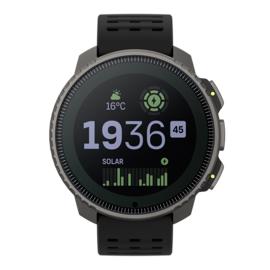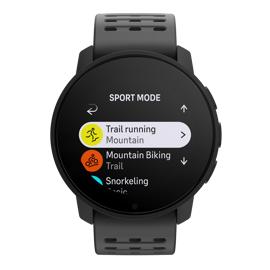That Janne Kallio works at Suunto on new product and solution concepts shouldn’t surprise anyone – after all, triathlon is his passion. Neither are we surprised that his book (Treenaa tehokkaasti, currently only available in Finnish) can help you learn to how to use technology to improve your endurance results. But the most surprising thing? Using training zones is easy. “Training does not need to be complicated,” says Kallio.
“The key aspect of reaching progress in one’s fitness is the ability to increase the physical load over longer period of time. Research shows that for people who are only starting to train, the easiest way to progress is to simply add one more training session in the week. Running three times a week versus two will improve fitness.”
But after a certain limit, simply running more is not enough.
“Running speed increases quite linearly on all distances up to about 60–70 km per week. After that the correlation isn’t as strong. When training more than 100 km a week your running speed does not necessarily get any faster.”
What Kallio is explaining is that adding volume to your training only helps up to a certain point. After that getting faster requires focus on other things, like the correct distribution of training intensity.
“Quite common training model is the so called polarized model where a big chunk, i.e. 80 % of training, is done aerobically, and a small portion of training with high-intensity. In order to follow this type of model one needs to be aware of one’s intensity levels.”
But what does intensity actually mean?
Training on different intensities stresses your body in different ways and leads to different kind of physiological adaptation. During light or moderate efforts the energy is supplied by the oxidative system, burning fat and carbs, and your blood lactate levels remain the same as at rest (0,8–1,5 mmol/L).
As the intensity increases, lactic acid starts to build in your muscles. Your body is still able to flush it out but the lactate levels rise above your resting levels. In training terminology this is your aerobic threshold (usually marked at 1,5–2,0 mmol/L).
If the intensity of the exercise intensifies even further, at some point your cardiovascular system can’t supply your muscles with enough oxygen, and lactic acid starts to build in your muscles faster than it can be removed. This point is called your anaerobic threshold (usually at around 4,0 mmol/L).
Based on these values, five zones are defined. Zones 1 and 2 are below aerobic threshold. Zones 3 and 4 between aerobic and anaerobic thresholds. Zone 5 is above your aerobic threshold. (Some of the zone-based models split zone 5 to fit dedicated sprint / explosive training into this intensity.)
Zone 1 is for recovery and warm-ups/cool-downs, zone 2 for long endurance sessions, zone 3 for tempo work, zone 4 for high-intensity intervals and zone 5 for maximal, VO2 max efforts.
The intensity zones are commonly defined based on heart rate, running pace or cycling power. Depending of the personal preference, type of training and equipment available one can use any of these models in their training.
How to define your personal heart rate zones?
It is important to know your zones to be able to follow a training plan and to keep structure in your training. “Without this knowledge easy runs often become too hard and hard ones are not hard enough. Zones help you understand and commit to what you are supposed to do,” Janne Kallio says.
There are basically three ways to define your heart rate zones: an estimate based on your max heart rate, a field test and a lab test.
Says Janne: “Statistically an estimate based on your max heart rate is valid, but as we know, individual differences are large especially in anaerobic threshold. The first challenge is the estimation of maximum heart rate and then the percentage of this to set the right level for anaerobic threshold. The percentage is an estimation as well.”
“The estimation of maximal heart rate is a good starting point. After some really hard workouts it’s definitely good to update your maximum heart rate based on personal experience. But for a goal oriented athlete, more accurate values are needed.”
The best way to get to know your personal HR zones is to take a VO2 max test with blood lactate analyses at a lab. But that is not necessary for every athlete. You can get a good idea of your personal intensity zones with a fairly straight-forward field test: After a good warm-up, run a 30-minute, race-pace effort. 10 minutes into the test hit the lap button on your Suunto. After the test use the average heart rate of the 20-minute lap as your anaerobic threshold.
Run hard the entire half an hour, but don’t start out too hard. After doing this test a few times you will learn to pace it better.
“After you have got your anaerobic threshold, it is time to make some calculations. There is some published research done on where the aerobic level fits based on anaerobic threshold,” says Janne. “It’s good to understand that an accurate anaerobic threshold is the basis of good zone distribution.”
Zone 5: Above your anaerobic threshold. Zone 5 ends at your max heart rate
Zone 4: 94–99 % of your anaerobic threshold. The upper limit of zone 4 is your anaerobic threshold
Zone 3: 89-93 % of your anaerobic threshold
Zone 2: 83-88 % of your anaerobic threshold. The upper limit of zone 2 is your aerobic threshold
Zone 1: <82 % of your anaerobic threshold. Zone 1 starts at your resting heart rate.
Note, these % values are from anaerobic threshold heart rate, not from maximal heart rate.
There are also other zone models that you can use. For example some of the zone models place your anaerobic threshold within zone 4 and in some models zone 1 does not start at rest heart rate but above it at 55 % of maximum heart rate.
Kallio says that’s not really important – it’s about the concept: “What one needs to understand is that the role of the zones is to ensure you train in different intensities.”
Different activities, different intensity zones
“It is also good to know that your heart rate zones differ slightly in different endurance sports. Activities where more muscles are working also require more oxygen meaning your anaerobic threshold is higher in these sports. You will reach your anaerobic threshold earlier in swimming than in cycling, running or cross-country skiing – in this order,” Janne reminds us. “So if you are, let’s say, a cyclist and a runner, you should test and define your zones for each of the sports to target your training intensities correctly.”
It’s just one example of how a little knowledge can help out a lot – a whole lot.
LEARN HOW TO USE SUUNTO VERTICAL'S INTENSITY ZONES
Main image © Philipp Reiter





